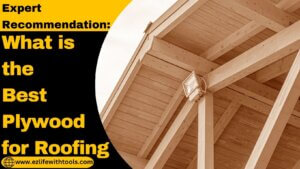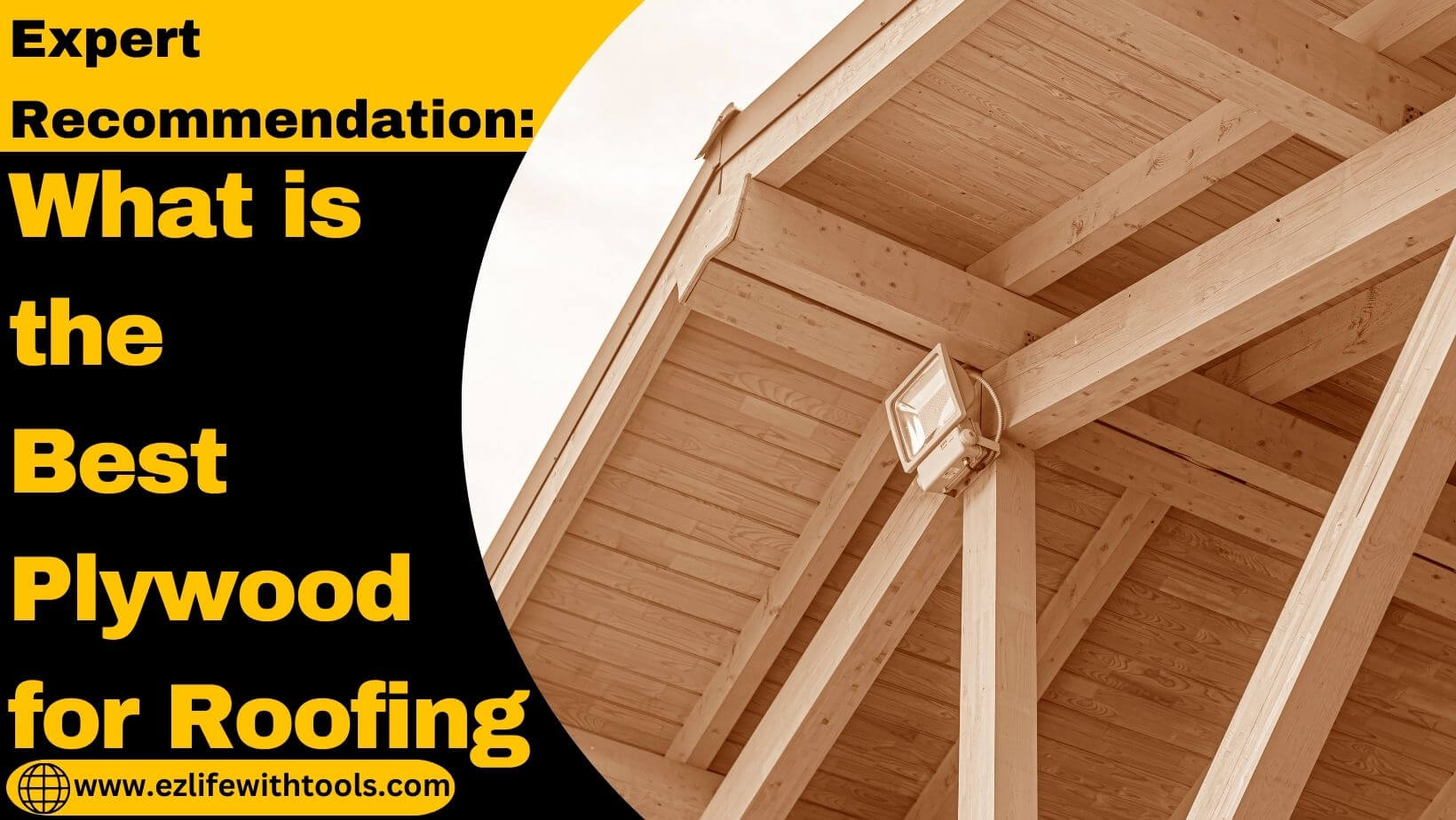What is the Best Plywood for Roofing: Expert Recommendation
Plywood is a foundational material that provides essential support and integrity to the roof. In the world of

construction materials, the term “best” is used as a special characteristic and consideration. Whether you’re a DIY enthusiast or a contractor, it is necessary to understand the nuances of plywood types.
If you are also a beginner, then you definitely want to know what is the best plywood for roofing.
In this article, we’ll explain all the best types of plywood for roofing with benefits, the selection process, factors to consider and the installation process.
It means it is a complete guide to understanding all the nuances of plywood types.
So, keep reading.
Role of Plywood in Roofing Structures
Plywood plays multiple roles in roofing structures. It acts as the roof deck or sheathing to provide a stable and even surface for the subsequent layers of roofing materials because it has the ability to bear the load of roofing components.
Plywood also contributes to the overall strength and rigidity of the roof and ensures it can withstand the forces of wind, snow, and other environmental factors.
Moreover, plywood serves as a substrate for various roofing accessories and installations. From supporting insulation to providing a secure base for flashing and underlayment, plywood acts as a versatile material that facilitates the proper functioning of the entire roofing system.
What is the Best Plywood for Roofing?
Types of Plywood for Roofing
Always remember that there are various types in the market according to different needs and preferences.
Today, I will explain only those types related to use in roofing. Let’s explore the primary types of plywood commonly used in roofing projects.
- Construction Structural Plywood
- CDX Grade Plywood
- Zip Wood
- FRT (Fire-Retardant-Treated) Plywood
1- Construction Structural Plywood
This type of plywood is created to provide strength and stability, which makes it suitable for roofing applications. It not only provides a reliable base for roofing materials but also ensures the structural integrity of the whole roofing structure.
2- CDX Grade Plywood
It is known for its durability and resistance to moisture; CDX grade plywood is commonly used in exterior applications. Its resistance to weather elements makes it an ideal choice for roofing projects. C and D are known as the front and back grades of these plywood sheets, while X is known as the adhesive material used to join all the plywood sheets together.
3- Zip Wood
Zip Wood is a premium exterior plywood recognized for its high quality and enhanced performance. It is made of 5 joined layers of plywood sheets along with moisture-proof layers. It is designed to fight the challenges posed by external elements to ensure a long-lasting and robust roofing structure.
4- FRT (Fire-Retardant-Treated) Plywood
It is treated with fire-resistant chemicals to add an extra layer of protection to the roofing system. It is particularly beneficial for those areas that are prone to wildfires.
For example, when, unfortunately, fire burns, this type of plywood releases some chemicals to increase its resistance to fire, which helps rescue departments save more lives and minimize losses.
Additional Roofing Material
OSB (Oriented Strand Board)
One another construction material for roofing is OSB. Although it is not plywood in the traditional sense, OSB is a popular alternative in roofing applications.
It consists of wooden strings that are compressed and bonded with resin. OSB is known for its strength and dimensional stability.
Applicability in Roofing
OSB can be a suitable choice for roofing projects, especially when cost is an essential factor. It performs well structurally and is commonly used for roof sheeting.
However, it’s essential to consider the specific needs of your project, as OSB can have different limitations than traditional plywood.
If you want to know about all types of plywood, you can also read our other article.
Related Article: How many types of Plywood
Factors to Consider When Choosing Plywood for Roofing
The selection of the right plywood for roofing involves many important factors to consider. Let’s explain the essential factors to consider before selecting plywood for roofing.
Climate Considerations
Roofs are exposed to diverse weather conditions, and the changes in climate affect them badly. Some regions are very hot, and some are very cool. So, according to your region’s environment, choose appropriate plywood.
Roof Design and Structure
The design and structure are also essential to determine the type of plywood needed. In the case of sloped roofs and flat roofs, choices can vary.
Because flat roofs always require rainwater drainage, while sloped roofs drain water automatically. So, choose the plywood, considering the roof’s design and structure.
Budget Considerations
If we talk about the budget, then the budget cannot be ignored. Of course, you would like your chosen plywood not only to be of good quality but also affordable.
So, choose plywood for the roof that suits your budget and quality. It’s crucial to strike a balance between cost and quality.
Local Building Codes and Regulations
Each area has different rules and regulations regarding the construction of various types of buildings, and some codes exist. There are also some rules regarding the construction of roofs in the same way.
Understand the plywood specifications outlined in your local building codes. Ensure compliance to avoid potential legal and safety issues down the line.
Strength of plywood
The strength of plywood is a primary consideration. Ensure that the plywood chosen can carry the load necessary to support the roofing material and withstand external forces.
Consider the specific needs of your roofing structure, considering factors such as climate and potential loads.
Rate of contraction and expansion
With the change in weather, the material used in the house also changes; that is, the applied wood used in the roofs of the house expands and shrinks. So, we must analyze before choosing the plywood for roofing. We need to find out the rate of expansion and contraction of our chosen plywood so we can avoid future problems due to expansion or contraction.
Thickness of Plywood
Before choosing the thickness of the plywood, estimate the weight of the material used in the roofing so that the thickness of the plywood can be chosen accordingly.
Because the weight-bearing capacity of the plywood of less thickness will be less, if the weight increases, problems can arise.
Span Between Rafters
The spacing of the rafters used in the construction of the roof structure is also a factor in choosing the thickness of the plywood. Because the rafters must distribute the roof’s weight evenly, larger spans may necessitate thicker plywood to distribute loads evenly and prevent structural issues.
Advantages of Using Plywood for Roofing
Plywood stands out as a preferred material in construction, especially for roofing. Let’s explain the various benefits that make plywood a popular choice.
Increased Stability
The layered structural design of plywood and each oriented layer at right angles contributes to the material’s ability to withstand external forces and maintain dimensional stability.
Load-Bearing Capacity
It is the impressive ability of plywood to maintain the structural integrity of the entire roofing system. This ability makes it suitable for supporting the weight of roofing materials and resisting external forces.
Chemical Resistance
Plywood can be treated with chemicals to increase its resistance to rotting and warping. This chemical resistance protects the material from the effects of moisture, prevents decay and extends its life.
Ease of Working
The consistent thickness of plywood makes the installation process easier. It has become the perfect choice among woodworkers due to the easy transformation of cutting and shapes according to the specific needs of the roofing project.
Conclusion
Choosing the best plywood for roofing is an important decision, including thoughtful consideration of project-specific needs, environmental factors, and long-term goals. By incorporating the insights shared in this article, you can complete your roofing project with confidence.
Assess the unique needs of your roofing project and select plywood accordingly that suits your area’s long-term goals and climate.
By following proper installation techniques and implementing regular maintenance practices can maximize the lifespan of your plywood roof.
Thanks for your time.
Best wishes

